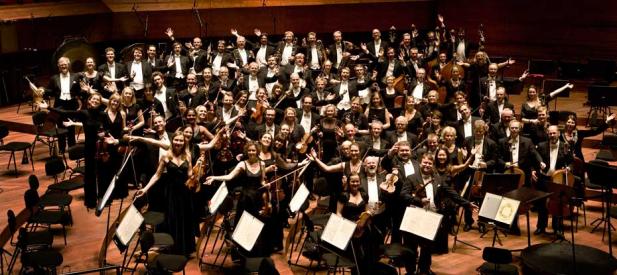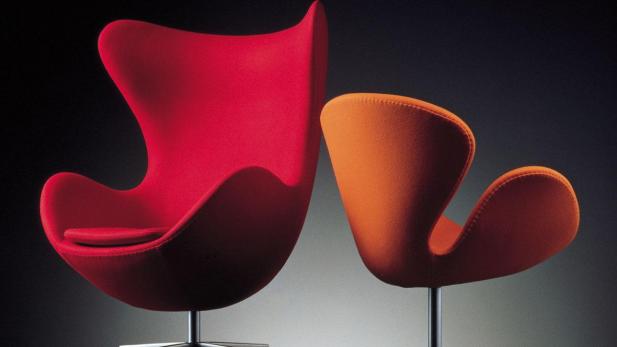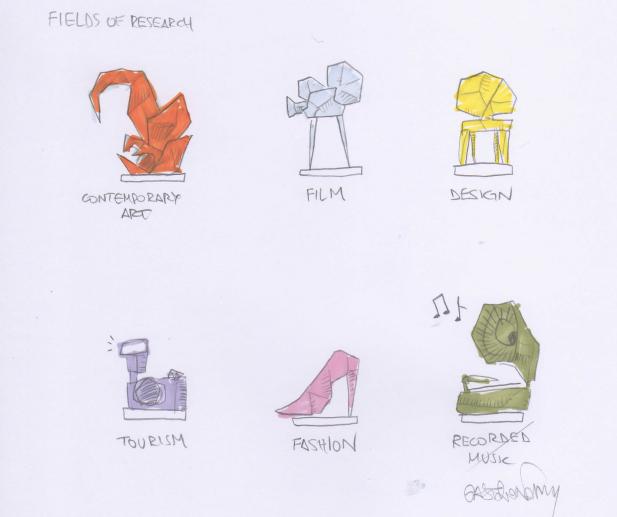imagine .. Creative Industries Research
Research
Fields of Research
Creativity vs. Commerce
The phrase ‘creative industries’ is chosen to focus on the nexus between culture and economy. A central problem in creative industries is the coordination of symbolic and material production, creativity and commerce. For example, many creative industries are characterised by the ‘double consumer’ bind: goods and services are created for targeted consumers, but with the financial backing of sponsor organisations, which often have an input in the content of what they are sponsoring. Creative industries have to meet the needs of both these consumer groups. This means that various forces of creativity and constraint come into play in the production of creative goods and services, and that different kinds of competing power are located in different parts of the industry. Centre members, therefore, examine the economic and social processes and norms underpinning the organisation of creative industries, as well as the effect these have on the content of their finished products, and the ways in which these products dovetail with consumer ‘demand’.
Design in Business
At the same time, however, design practices find their way into many business-related areas outside the field of creative industries per se and these involve using creative resources in a structured way in order to develop objects, artefacts, systems and services. In this respect, design becomes a particular set of tools that companies have at their disposal to enable innovation, so that more industries may become more creative with time. This raises an issue of how to exploit these tools, how to integrate design with other business functions and what strategies are available to various companies as part of their ‘knowledge economy’.
Creative vs. "Humdrum"
Creative industries rely on complex teams of differentially skilled personnel to coordinate their activities temporally to produce goods and services of infinite variety. They are characterised by a broad distinction between personnel involved in ‘creative effort’, on the one hand, and in ‘humdrum commerce’, on the other. No two industries, however, are quite the same. Rather, each creative industry is organised around its own particular social world: that is, a variety of individual and institutional agents, whose collaborative effort makes the product, for which a creative industry is noted. These social networks of cultural production may operate at local as well as transnational levels. There are differences in scale, depending on the industry concerned. Some are dominated by a few multinational corporations; others by small-scale fragmented companies, making up a trans-urban sector. Yet others are marked by interaction between large and small institutions.
Global Networks
Global networks are also an integral part of the centre members’ interests. These refer both to processes of geographical segmentation in creative industries, and to the interconnection between places, industries and people in different centres and peripheries that are linked by global systems of distribution and market research. We are particularly concerned with flows of knowledge and information, on the one hand, and with labour and production processes, on the other. Each creative industry constitutes a field of organisations, markets and networks. Nevertheless, each industry can be, and often is, linked to other industries by means of celebrities who then enable new fields to form out of previously separate industries (such as those of film, publishing, fashion, toys and games). Different creative industries have different network geographies, often located in ‘global cities’. Fashion design, for example, is centred in Paris (with London, Milan and New York as competing centres).
Growing Importance of Asia
Yet, the substantial part of the garment manufacturing is centred in East Asia with business people from Hong Kong, Korea and Taiwan playing a crucial intermediary role. Asian creative industries are themselves becoming global players in the generation of creative products (for example, the Bollywood and Hong Kong film industries, or Japanese electronic goods, design and anime cartoons). Therefore, in mapping transnational creative industries centre members pay attention to the centres as well as to the peripheries.

Academic Profile
Research carried out in imagine.. is:
- Cross-Disciplinary, bringing together researchers in the fields of economics, sociology, economic geography, gender studies, linguistics, social anthropology, and strategic design
- Multi-theoretical, drawing on critical analyses in the fields of organisation, management, aesthetics, cultural studies, design, globalisation, the history of ideas, marketing, media, psychology, and semiotics, as well as regional and urban development
- Pluralistic in Methodology, making use of both quantitative and qualitative methods that include statistical and textual analysis, in-depth interviews, long-term participant-observation fieldwork, and consumer surveys
- Cross-Country Comparative, both within the Scandinavian region and Europe more generally, but also, importantly, globally: Ongoing projects encompass comparisons between the Asian countries (in particular, China, Hong Kong and Japan), Europe, India and the US.
imagine.. is formed around a number of scholars who are working in different departments at Copenhagen Business School. As a result, they bring a variety of disciplinary interests to bear on the analysis and understanding of creative industries. Some, for example, are interested in the extent to which creative industries conform to or differ from other industries in their organisational forms. To what extent does the very notion of “creativity” affect social interaction and output in an organisation? Others look at the role of design in the marketing of products. How is design incorporated in the production process and what are the tensions that exist between those working in design and those employed in other parts of an organisation’s structure? Yet others are concerned with the commodity chains formed by creative products. How are production processes linked to the distribution, marketing and use of fashion, art, or film, and how do such products bring people in different parts of the world together in global networks?
Strategic Objectives
- imagine.. members study creative industries at firm and inter-firm, national and international levels, in the context of transnational connections and global networks
- The centre supports conceptual and applied research, and attracts and coordinates ongoing research while stimulating new research initiatives
- imagine.. members explore, develop, confront and combine different methods when addressing common research questions outlined in the centre's working plan. In this way, they work towards building a framework for analysing the scope, and comparing the explanatory merits, of different methodological approaches
- imagine.. members interact with the national and international business community, as well as with policymakers
- The centre aims to train future researchers for careers in research at universities, as well as in the corporate and public sector
- The centre provides high-level guidance and supervision for local and visiting doctoral students, and offers or contributes to doctoral courses and training activities within its academic field
- The centre gives priority to the creation of an international study environment through the continuous presence of foreign research students and senior researchers and through a high degree of interaction with leading international programmes for research training within the field
- The centre aims to create a forum for knowledge sharing and encourage publication of research activities in internationally referred journals and books
- The centre is developing a special relationship with global creative industries and networks in order to strengthen related activities at Copenhagen Business School.

Past Projects:
Cre8tv.eu - research project running from February 2013 to March 2016 and supported by a grant of the 7th Framework Programme of the European Commission (Socio-economic Sciences and Humanities). The Cre8tv.eu is a multi-partner and multi-disciplinary project, which will unveil the significance of creativity and cultural and creative industries in Europe (and beyond).
The Danish Copyright Industries: A Mapping and Discussion - 2008 - 2010
Creative Encounters - 2007 - 2011; Creative Encounters seeks to explore the socio-economic organization of creative industries in a global context and focuses in particular on three sectors that are of some importance in Denmark: (a) Fashion and Luxury; (b) Film and Media; and (c) Place Branding, Art and Culture. The aim of the research programme is to uncover the complex interplay between economic and cultural forces that characterises work practices, professions, organizations, and industries. To this end, Creative Encounters will engage in knowledge-producing partnerships with a broad range of business and educational organizations located both in Denmark and abroad.
The socioeconomic profile of the Creative Class - 2007
Rammebetingelser for Københavns Kreative Erhverv - 2006
Kortlægning af den Danske Ophavsretøkonomi - 2006
Kunst, kompetence og konkurrenceevne i den danske oplevelsesøkonomi - 2005 - 2010; As part of the Tuborg Foundation's 75th anniversary the Foundation takes a joint initiative with Copenhagen Business School to promote the Danish experience economy. Tuborg Foundation grants 6.2 million. kr. for research of Art, Competence and Competitiveness in the Danish experience economy. The project is the first of its kind in Denmark and includes a survey of the Danish experience economy, a study of the barriers to growth, and the development of future management tools. It is carried out in close cooperation with industry and conducted by CBS research center Imagine .. Creative Industries Research. The project runs over a 3-year period.
CINEMA Project - 2005 - 2008; ‘CINEMA – Organising and Managing Creative Enterprises’ is a research project concerned with the study of the film industry and the process of making films, studying how innovative, high framework filmmakers organise, manage and combine creativity with commercial interests. The joint research project involves Jesper Strandgaard, Per Darmer, Chris Mathieu, Sara Malou Strandvad (PhD student) and Jesper Thomas Schlamovitz (PhD student). Samarbejdspartnere: Det Danske Filminstitut, Danske Filmskole, Dansk Instruktør Forening, Nordisk Film, Zentropa, Nimbus Film, Reiner Grasten Film.
Capital Meets Creativity - 2005 - 2006; Center for Intellectual Property Studies (CIP) has together with Film i Väst, Lillehammer Kunnskapspark, Lillehammer University College, Copenhagen Business School (CBS), IceTec and Cimfunds entered into a collaboration regarding the development of an educational tool. This cooperation is part of a larger project called “Capital Meets Creativity” which was initiated by the parties due to the realization that the creative industries were facing a number of challenges when it came to the ability to capitalize on the creative efforts and to attract investments to the same. Research Partners: Center for Intellectual Property Studies (CIP), Film i Väst, Lillehammer Kunnskapspark, Lillehammer University College, Copenhagen Business School (CBS), IceTec and Cimfunds.
Technology, Talent and Tolerance in European Cities: A Comparative Analysis - research project from January 2005 to June 2007. Talent attraction and the factors that make places attractive to creative, mobile talent are key emerging areas of policy interest. The fundamental aim of this research is to understand the performances of regions across the UK and Europe with reference to the knowledge-based economy and to assess the extent quality of place – that is amenities, lifestyle and environmental quality – affect the ability of regions to attract talent and to generate and sustain knowledge-based industry. The project will examine the relationship between talent, technology, creativity and diversity in city-regions in UK compared to those in other European countries and North American metropolitan regions. This work offers a means to further investigate the importance of location decisions in the knowledge economy, the importance of higher education in the knowledge economy and the importance of immigration and settlement, as well as the nurturing of arts and creativity.
Hovedstadens Kreative Kapital/Den Kreative Klasse kortlægges i Danmark - 2005 - 2006; The concept of the Creative Class is tremendously hyped internationally. In the United States the cities are being ranked after the indexes that have been developed by Richard Florida - an American professor of regional economic development and the originator of the concept of the Creative Class. In Denmark, he inspired the Social Liberal Party to the biggest election victory in 30 years. His ideas have resonated in public debates and aroused a critical attitude to the concept and the values presented here. But can we talk about the Creative Class in Denmark? How do you map it? Is the concept relevant in the Danish context? Research Partners: Momsfondet; University of Lund, Sweden; University of Oslo, Norway; University of Toronto, Canada; STEP group, Oslo, Norway; University of Cardiff, Wales; University of Bonn, Germany; University of Utrecht, The Netherlands; Professor Markku Sotarauta, University of Tampere, Finland.

Contact
imagine .. Creative Industries Research
Copenhagen Business School
Kilevej 14A, 4. sal
DK-2000 Frederiksberg
